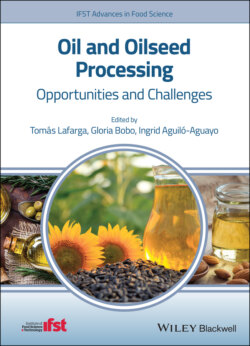Читать книгу Oil and Oilseed Processing - Ingrid Aguilo-Aguayo - Страница 19
1.2.5 Maize
ОглавлениеMaize (Zea mays L.), also known as corn, is a cereal grain from the family Gramineae, which includes plants such as wheat, rice, or sugarcane. Cereal grains are key‐importance crops as they provide humans with more nourishment than any other food class and nearly 50% of the total caloric requirement (Ranum et al. 2014). Maize was first domesticated by indigenous peoples in the mid‐ to low‐land regions of what today is known as Mexico, around 9000 years before present (van Heerwaarden et al. 2011). Today, maize is a staple food in many parts of the world, with the total production of maize surpassing that of other staples including wheat (UN 2019). Table 1.1 lists some products recently launched into the market manufactured using maize oil. Production of maize showed an important increase in both area harvested and total production over the last decade. Currently, world area harvested is approximately 197.15 Mha, showing an important increase from 2007 when approximately 158.67 Mha of maize were harvested. World production of maize was 1134.74 Mt in 2017. Maize ranked fifth in the most produced commodities during 2017 according to data accessed from FAOSTAT, only surpassed by “total cereals,” rice, sugar cane, and “total coarse grain.” Approximately 50.9% of the maize produced during 2017 was cultivated in the Americas, followed by Asia and Europe with production shares of 31.9 and 9.7%, respectively. Largest producers were the US, China, Brazil, Argentina, and India with production quantities of 370.96, 259.07, 97.72, 49.47, and 28.72 Mt in 2017. Recently, the USDA predicted lower maize imports and production for 2018/2019. Larger maize exporters during 2016 were the US, Argentina, Brazil, and Ukraine with 55.99, 24.50, 21.87, and 11.01 Mt, respectively. Increased corn exports in Argentina and Ukraine are expected, partially offset by reductions for South Africa and Mexico (USDA 2019b). Japan, Mexico, the Republic of Korea, and Vietnam were the larger importers during this period with approximately 15.34, 14.10, 9.78, and 8.05 Mt, respectively (UN 2019). As a crop, maize is highly productive and versatile, and responded successfully to investments in research, breeding, and promotion. However, the current corn production system can be considered inefficient, at least at feeding people. Only a small fraction of the maize grown over the world is consumed directly by humans. Most of the maize currently harvested today is being indirectly used for human consumption as animal feed or as raw material for the production of maize‐derived products such as corn starch or corn syrup, or used for other industrial purposes such as the production of ethanol. An important part of maize production, approximately 40%, is being used as a raw material for the production of ethanol used as a motor fuel (Ranum et al. 2014). The utilization of maize for producing biofuels has a strong impact on production and trade. Indeed, total corn use was predicted to decrease by 165 M bushels (approximately 4.19 Mt) mainly caused by a 40 M bushel decrease (approximately 1.01 Mt) in the amount of corn used for ethanol production (USDA 2019b).
Only a small amount of the maize currently cultivated is used for oil production. Total maize oil production during 2014 was 3.18 Mt, led by the US, China, Turkey, and Brazil with oil production quantities of 1.82, 0.26, 0.19, and 0.09 Mt. Major oil exporters during 2016 were the US, Turkey, and Spain with approximately 0.47, 0.05, and 0.04 Mt of oil exported. Spain was also one of the largest importers, with 0.09 Mt, only surpassed by Libya, who imported 0.10 Mt of maize oil during 2016. Overall, although human consumption of maize has remained steady over the last years, its global production has slightly but steadily increased mainly caused by an increase in its use for animal feed and for biofuel production.
